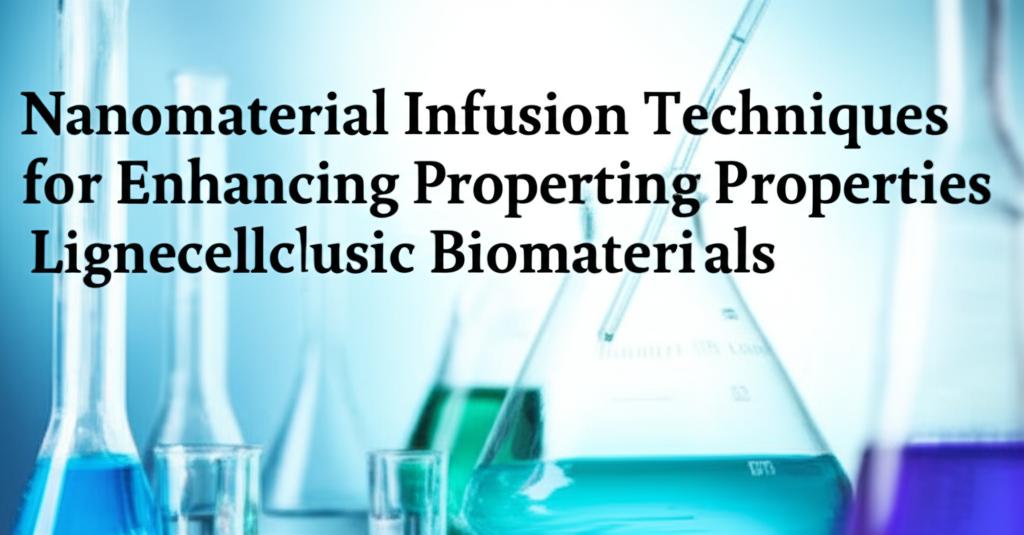Lignocellulosic biomaterials, derived from sources like wood and agricultural residues, are abundant, renewable, and form the structural backbone of plants. However, limitations such as susceptibility to moisture, decay, and modest mechanical properties compared to synthetic alternatives can restrict their applications. Nanotechnology offers promising routes to overcome these limitations by infusing these biomaterials with nanomaterials, creating composites with significantly enhanced characteristics.
Why Nanomaterials Boost Lignocellulosic PropertiesThe effectiveness of nanomaterials stems from their minuscule size and consequently high surface-area-to-volume ratio. This allows for:
- Deep Penetration: Nanoparticles can penetrate the porous structure of lignocellulosic materials, even entering the nanoscale voids within plant cell walls.
- Enhanced Interaction: Their large surface area maximizes contact and interaction with the cellulose, hemicellulose, and lignin components of the biomaterial.
- Unique Functionalities: Nanomaterials possess distinct physical and chemical properties (e.g., catalytic, magnetic, conductive, antimicrobial) that can be imparted to the bulk biomaterial.
Several strategies are employed to integrate nanomaterials into lignocellulosic matrices:
- In Situ Synthesis/Precipitation: This advanced method involves synthesizing the nanoparticles directly within the lignocellulosic structure. For example, wood can be treated with precursor solutions (like iron salts) which are then chemically reacted (e.g., via coprecipitation) inside the wood's cellular structure to form nanoparticles (like iron oxide). This technique ensures excellent dispersion and integration of the nanoparticles within the cell walls, leading to properties like magnetism, improved thermal performance, and enhanced stiffness.
- Impregnation: This is a common method where the lignocellulosic material is soaked or infused with a suspension containing pre-synthesized nanoparticles. Techniques like vacuum or pressure treatment can enhance the penetration depth and uniformity of the nanoparticle distribution within the material's porous network. This method is versatile and applicable to various nanoparticles and lignocellulosic types.
- Coating: Nanomaterials can be applied as a coating on the surface of the lignocellulosic material. While this primarily modifies surface properties, it can be effective for applications like UV protection, water repellency, or antimicrobial surfaces.
- Enzyme Immobilization onto Nanomaterials: While not direct infusion into the structural material itself, nanomaterials (especially magnetic ones) are used as supports to immobilize enzymes (like cellulases). These enzyme-nanoparticle conjugates are then used to more efficiently break down lignocellulosic biomass for biofuel production. The nanoparticles enhance enzyme stability, activity, and allow for easy recovery and reuse (e.g., using magnets), making processes more cost-effective.
- Mechanochemical Methods: Techniques like ball milling can be used to blend lignocellulosic materials (like lignin powder) with precursor salts (e.g., silver salts) under solvent-free conditions. The mechanical energy facilitates the reduction of the metal salt and the formation of nanoparticles directly within the biopolymer matrix, creating functional composites in a single step.
- Using Lignocellulosic-Derived Nanomaterials: Cellulose and lignin themselves can be processed into nanoparticles (nanocellulose and nanolignin). These bionanomaterials can then be used as reinforcements or functional components in creating advanced lignocellulosic composites, leveraging the inherent properties of the biomass components at the nanoscale.
Infusing nanomaterials leads to a wide range of improvements:
- Enhanced Mechanical Properties: Nanoparticles like nanocellulose, nanolignin, or mineral nanocrystals (e.g., iron oxyhydroxide) incorporated into the cell wall can significantly increase stiffness, hardness, and overall strength of wood and other lignocellulosic composites.
- Improved Durability: Enhanced resistance to moisture uptake, decay fungi, and insects can be achieved using nanoparticles like zinc oxide, copper, or silver, extending the service life of the biomaterial.
- Added Functionalities:
Magnetism: In situ synthesis of iron oxide nanoparticles creates magnetic wood composites useful for electromagnetic shielding or potentially data storage.
Conductivity: Incorporating conductive nanoparticles (like carbon nanotubes or certain metal oxides) can make lignocellulosic materials suitable for sensor or electronic applications.
Antimicrobial Activity: Silver nanoparticles infused into lignin or cellulose matrices create materials effective against bacteria, usable in filters or medical applications.
Catalytic Activity: Nanoparticles acting as catalysts enhance the efficiency of converting lignocellulosic biomass into biofuels (bioethanol, biohydrogen, biogas) by improving pretreatment and hydrolysis steps.
Controlled Release:* Lignocellulosic nanomaterials can act as eco-friendly nanocarriers for the controlled release of agrochemicals like pesticides, improving efficiency and reducing environmental impact.
- Thermal Stability: Certain nanoparticles can improve the thermal resistance and fire retardancy of lignocellulosic materials.
Nanomaterial infusion techniques are rapidly evolving, paving the way for high-performance, sustainable materials derived from renewable lignocellulosic resources. Ongoing research focuses on scaling up cost-effective and environmentally friendly infusion processes, understanding the long-term stability and environmental fate of these nanocomposites, and precisely tailoring nanostructure-property relationships for specific advanced applications. These developments are crucial for expanding the use of lignocellulosic biomaterials in construction, packaging, energy, electronics, and biomedical fields, contributing to a more sustainable circular bioeconomy.

